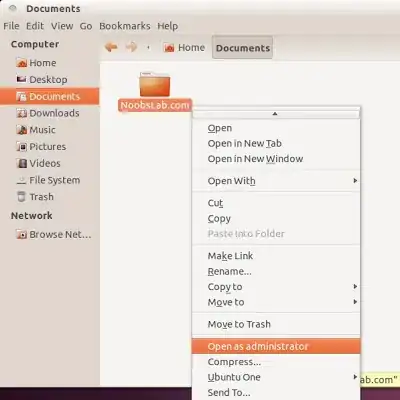More specifically the
/etc/apt/
folder. I need to delete some files and replace
/etc/apt/sources.list
with a newer version.
More specifically the
/etc/apt/
folder. I need to delete some files and replace
/etc/apt/sources.list
with a newer version.
To open the folder as root in the grapical file manager, run the following command:
gksu nautilus /etc/apt/
If you wish to do your operations from the command line, the following command enters the intended directory and makes you root. However, you would be better off using the first method above.
cd /etc/apt; sudo -i
Ubuntu 16.04 and above
sudo apt-get install nautilus-admin
Then
nautilus -q
Open Nautilus and you'll see an option Open as Administrator option in the context menu of every directory.
To install Open-as-Administrator in Ubuntu open Terminal (Press Ctrl+Alt+T) and copy the following commands in the terminal:
sudo add-apt-repository ppa:noobslab/apps
sudo apt-get update
sudo apt-get install open-as-administrator
After installation type this command to restart Nautilus:
nautilus -q
Reboot

Ubuntu 16.04
sudo apt-get install -y nautilus-admin
Then
nautilus -q
Nah ! do a simple thing first. Create a custom file manager. Its easy.
Here how you can do it:
[Desktop Entry]
Name=Nautilus
Comment=Browse the filesystem with administrator rights
Exec=gksudo nautilus
Icon=file-manager
Terminal=false
Type=Application
Categories=Application;System;
Now save the file as Nautilus.desktop on your desktop.
(desktop is the file extension).
Now Open:
/home/your user name/.local/share/applications
and cut/paste Nautilus.desktop file into there.
Now open dash and search for "Nautilus". It will open up the default file manager with root permission. Now you can navigate to any directory and delete anything you want.
Just use
gksudo nautilus --or -- gksu nautilus
or any other file explorer of your choice.
See Also What is the difference between “gksudo nautilus” and “sudo nautilus”?
In a Terminal you can use:
sudo -e /etc/apt/sources.list
Note: If you prefer to use Graphical Software you should use gksudo in Gnome:
gksudo gedit /etc/apt/sources.list
or kdesudo in KDE:
kdesudo kate /etc/apt/sources.list
Enter your user password (not root) and you will edit file as root